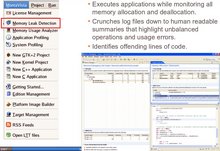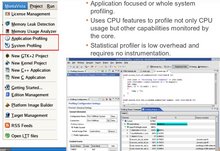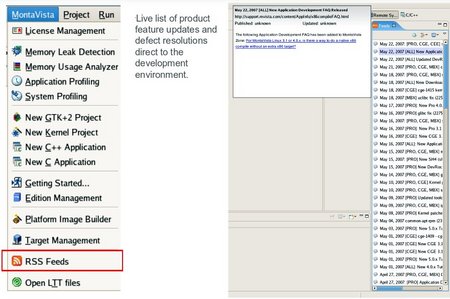MontaVista rev’s its Carrier Grade Linux distro
Nov 14, 2007 — by LinuxDevices Staff — from the LinuxDevices Archive — 5 viewsMontaVista is readying a new version of its “carrier grade” Linux distribution. MontaVista Linux Carrier Grade Edition (CGE) 5.0 — expected to ship Dec. 17 — is said to offer greater scalability, reliability, and field-serviceability, along with added “NSA-level” security features and new DevRocket development tool capabilities.
MontaVista calls CGE 5.0 a “field-proven, production-quality” OS targeting telecom and network equipment, including ATCA- and MicroTCA-based platforms. Specific target devices include SGSNs (serving GPRS support nodes), GGSNs (gateway GPRS support nodes), and softswitches.
Background on CGE
MontaVista says CGE is based on standard Linux, enabling engineers to easily incorporate off-the-shelf Linux utilities. At the same time, the distribution is said to undergo rigorous testing, debugging, and “productization,” enabling reliability of up to “six nines,” the vendor claims.
Jim Ready, who founded MontaVista and now serves as CTO, enthuses, “We were recently told by NTT DoCoMo, Japan's largest carrier, that they've achieved six nines of network uptime over the last 18 months using CGE on NEC equipment. We believe it's the first time Linux has demonstrated six nines in a live carrier network.”
MontaVista calls its CGE product the “most widely-deployed Linux in the carrier grade market.” Launched in 2002, CGE a year later became the first distribution to register compatibility with the Carrier Grade Linux (CGL) specification. Today, CGE is “preferred” by seven of the top eight network, MontaVista claims.
Dan Cauchy, MontaVista marketing director and chair of the CGL working group, clarifies, “It used to be more, then Nokia and Siemens merged, then Alcatel and Lucent. We continue to dominate this space over our competitors.”
MontaVista's competitors in the carrier systems market include, among others, Wind River, Red Hat, Novell/SUSE, Asianux, and Performance Technologies (a network equipment provider that integrates its own Carrier Grade Linux distribution).
CGE comes with an Eclipse-based DevRocket toolsuite. The suite is available in a fully featured version supporting kernel development, as well as a low-cost version for application developers only. The tools offer several features “exclusive” to MontaVista, the vendor claims. These features are shown in the screenshots below.




(Clockwise) DevRocket's LTTng (Linux trace toolkit, next-generation) interface, memory leak detection, memory analyzer, and profiling tools
(Click any screenshot to enlarge)
New in CGE 5.0
CGE 5.0 is based on a 2.6.21 Linux kernel, with real-time features from 2.6.22 backported to it. Interestingly, MontaVista uses the same kernel version at the other end of the virtual wire, in its Mobilinux OS for mobile phones, last revised in September.
In addition to a Linux kernel, CGE 5.0 includes about 800 software packages. There are about 1,500 patches that are “fully tested and skillfully merged,” the company says.
CGE 5.0 supports development with version 4.2 of the GNU Compiler Collection (gcc), and is the first of MontaVista's OSes to add 4.x gcc support. The C library is based on glibc 2.5.90.
Other touted new features in CGE 5.0 include several MontaVista exclusives, as well as several features based on interesting open source technologies. Proprietary feature additions include:
- Run-time Application Patcher — Said to let field engineers “apply a binary patch to a live system while it runs, without incurring any downtime.” Primarily intended as a support tool for deployed networks, RTAP is “thread-safe, multicore-safe, and runs at kernel-level,” Cauchy said.
- Flight Recorder — Likened to an airplane's “black box,” the recorder logs scheduler activity and other diagnostics, including diagnostics added by users (it's extensible). Carriers can send the data back to equipment makers for remote diagnostics. Cauchy commented, “It can be configured to write to flash, or to a disk at panic time. It lets you see what was happening just before the crash, which is often more useful [than crash dump snapshots].”
- Field-Safe Application Debugger — A remote debugging system aimed at letting engineers set “tracepoints” in running applications, FSAD is said to have a small memory footprint and limited CPU usage, so as not to halt execution or affect services.
Features apparently based on open source software, meanwhile, include:
- Live application core dump — Claimed capable of stopping a running application, taking a core dump sample, and restarting the application, all within “tens to hundreds of milliseconds”
- “Integrated” real-time response — MontaVista says CGE 5.0 includes native Linux real-time features from both MontaVista and the community, including hrtimers, fast mutexes, threaded soft and hard IRQ handlers, and application-level priority inheritance and queuing. The result is preemption response latency of 50 microseconds — claimed good enough to let carriers “consolidate legacy RTOS and Linux applications onto a single system, while meeting their real-time requirements.”
Asked if carriers are in fact adopting Linux on the dataplane — traditionally the exclusive domain of RTOSes (real-time OSes) such as VxWorks and OSE — Cauchy commented, “Oh, it's real. It's definitely happening. Carriers don't want to run Linux on the control plane, and VxWorks on the data plane.”
Ready elucidates, “It's an illusion that the RTOS is used in the data path. No software is fast enough to do real dataplane processing in telecom infrastructure. The data plane has extreme hardware acceleration, and what you need there is an OS to control the hardware and interface with the control plane. As long as you're reaching 50 microsecond latencies, you really don't need an RTOS there at all.”
Ready adds, “Look at Cavium-based blades with 32 cores (story). Because of the speeds required, people are dedicating each of those cores to specific tasks. Linux is just the tie-in to the control-plane.”
- Microstate accounting — New high-resolution process accounting aims to let engineers measure process and thread utilization more accurately, in order to better predict hardware requirements. To demonstrate the inaccuracy of older statistical sampling-based process accounting utilities such as “top,” MontaVista suggests running the following function:
int
main(int argc, char *argv[])
{
for (;;) {
struct timeval tv = { .tv_sec = 0, .tv_usec = 1 };
struct timeval then;
/* Wait until the next tick. */
select(0, NULL, NULL, NULL, &tv);
/* Now spin until half a tick goes by. */
gettimeofday(&then, NULL);
tv = then;
then.tv_usec += TICK_US / 2;
while (then.tv_usec >= 1000000 {
then.tv_usec -= 1000000;
then.tv_sec += 1;
}
while (cmp_tv(&then, &tv) > 0)
gettimeofday(&tv, NULL);
}
}On Fedora Core 5, “top” showed the function consuming zero CPU. Red Hat Enterprise Linux (RHEL) 4 showed it consuming 27.4 percent, while RHEL 5 showed 11.8 percent. The Microstate Accounting feature in CGE 5.0, meanwhile, accurately showed 49.7 percent, MontaVista said.
- “NSA-level” security — MontaVista claims CGE to be the first carrier-grade OS to include the SELinux (security-enhanced Linux) recommendations created by the National Security Agency (NSA). In all fairness, however, SELinux has long been a cornerstone technology in RHEL, which is often deployed in carrier systems, despite not being CGL-registered.
MontaVista also adopted SELinux — albeit with vastly different policies — in the latest release of its Mobilinux mobile phone OS. And, it extended its Eclipse-based DevRocket toolsuite with a “SLIDE” tool aimed at helping users develop and deploy SELinux security policies, which like Internet routing policies can become quite complex.
- Tools integration — CGE 5.0 adds more hooks for MontaVista's DevRocket IDE (integrated development environment), including hooks for “integrated memory leak detection, performance profiling, memory usage analysis, and system tracing.”
- RSS reader — One nifty-looking new feature in DevRocket is an RSS feed reader, which the company uses to push news about patches and fixes to customers

In best tradition of technology reuse, MontaVista leveraged RSS feed technology in DevRocket's new notification system
(Click to enlarge) - Multicore support — CGE 5.0 and the DevRocket tools are said to support both symmetrical and asymmetrical multiprocessing (SMP and AMP).
- Carrier standards compliance — CGE 5.0 was “designed to comply” with CGL 4.0, with the Scope Alliance's Linux Profile 1.2, and to support the PICMG's ATCA (Advanced Telecommunications Computing Architecture) and MicroTCA specifications.
- Ecosystem growth — Numbering 70 companies, MontaVista's third-party provider network includes middleware, application, and tools providers, such as Oracle, MySQL, Enea, and VirtualLogix.
In a statement, Cauchy said, “The carriers and NEPs who run their businesses on MontaVista Linux have worked closely with us to make certain that MontaVista Linux CGE 5.0 offers the highest levels of availability, field serviceability, and security of any carrier grade OS.”
Sani Rus, system software development manager at network equipment provider Iskratel, stated, “We see CGE 5.0's new features for high availability and security as providing competitive advantages for Iskratel's network equipment.”
Availability
MontaVista Linux Carrier Grade Edition 5.0 is scheduled for release on Dec. 17. Architectures supported will include Intel x86/x86_64 and PowerPC, with MIPS to follow in the first quarter of 2008, MontaVista said.
This article was originally published on LinuxDevices.com and has been donated to the open source community by QuinStreet Inc. Please visit LinuxToday.com for up-to-date news and articles about Linux and open source.